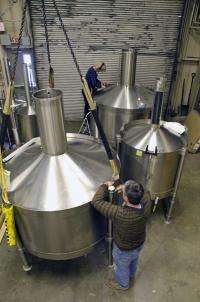Petroleum volume: Getting calibrations in the can

(Phys.org) -- The volume of oil and oil products moving through America’s pipelines, waterways, roads, and rails borders on the unimaginable.
“Look at it this way,” says John Wright, a Project Leader in PML’s Fluid Metrology Group. “Per capita consumption of petroleum in the United States is 10 liters per day. And there are 300 million people. That’s three billion liters moving around each day, and usually being metered several times along the way. The infrastructure requirements are mind-boggling.”
So is the value. Three billion liters is about 19 million barrels. And with crude oil priced around $100 a barrel these days, approximately $2 billion worth of petroleum travels from multiple sellers to multiple buyers every 24 hours. Clearly, even tiny errors in measurement can amount to a great deal of money.
To ensure maximum accuracy, the U.S. petroleum industry relies on volume measurements traceable to NIST, and specifically to the Flow Metrology Group in PML’s Sensor Science Division. Customers bring in their own “field test measures” – stainless steel containers ranging in capacity from four liters to 8,000 liters, made with graduated necks but informally called “cans” – to be calibrated.
The cans are used to calibrate various “prover” mechanisms that measure movement of volume per unit time, and the provers in turn are used to calibrate various kinds of flowmeters. Because the provers and meters differ widely in capacity, a variety of can sizes is typically necessary.
For example, Alberta-based calibrators Glenn Antoniuk and Barbara Germin recently spent two weeks at NIST calibrating 13 cans ranging from 1 to 500 gallons. That may seem like a long time, but the process is laborious and painstaking. Each can is cleaned and thoroughly dried, carefully leveled, and weighed empty. Then the can is filled with purified water and weighed again. This entire process is repeated five times for cans of 380 liters or less, and at least twice for larger cans.
“We often calibrate over 100 measures a year here, from all sorts of customers,” says Fluid Metrology technician Sherry Sheckels, “including some designed to be transported by barge out to offshore oil platforms for on-site calibrations.”
Not surprisingly, there are industry standards specified by the American Petroleum Institute that govern each stage of the calibration operation. For example, cans smaller than 20 liters are drained by pouring through the neck while tilted to 70 degrees from horizontal (not 90 degrees, which is completely vertical) and there are standardized drainage and drip times.
Because the mass, density and temperature of the water are extremely well known, container volume can be determined to high accuracy after correcting for factors such as thermal expansion of the metal. The petroleum industry expects uncertainties less than 0.05 % for custody transfer or billing applications. NIST’s can-volume calibrations are in the range of 0.01 percent for very large cans.
The other variable of intense interest is how the measurements change or “drift” over time. “If our calibrations or our customers’ calibrations or the pipe-provers’ change too much,” Wright says, “then there’s a lot of retroactive money that changes hands. It can amount to very large sums because the volume is extraordinarily high.”
Glenn Antoniuk, whose company conducts calibrations from western Canada down to the Gulf Coast, agrees: “I’ve heard of settlements that have been in the millions.”
State laws governing the volumetric accuracy of products delivered to the consumer usually specify 0.5% uncertainty, and end-point distribution has to be monitored from time to time. “Five gallon cans are used at gas stations by state labs to make sure that pumps are calibrated properly,” Wright says.
Because petroleum and other products sold by volume can cross many national borders, it is highly important that international standards agree as closely as possible. This necessitates round-robin comparisons, and Wright is now preparing to test a set of precision containers from Mexico.
“In general, the agreement among different national metrology institutes is extremely good,” Wright says. “But that doesn’t mean we can ever stop measuring.”
Provided by National Institute of Standards and Technology



















